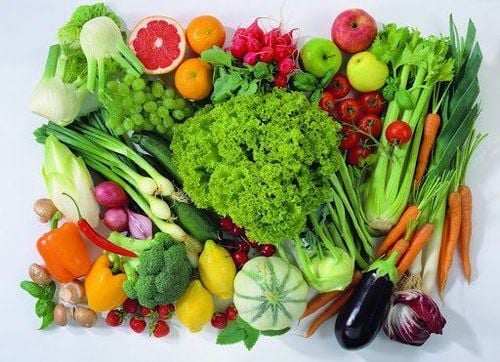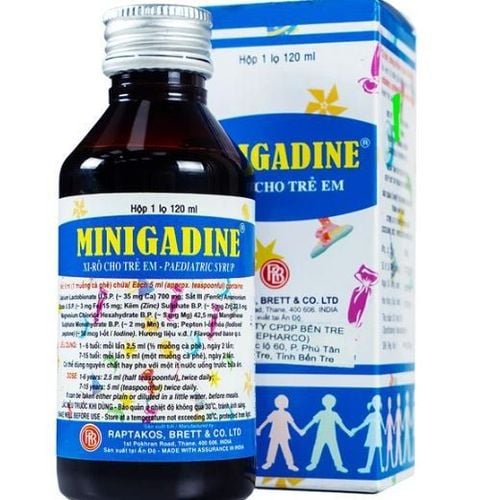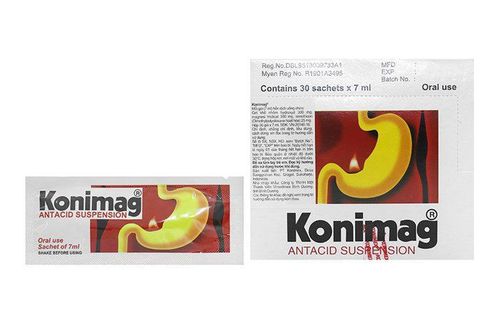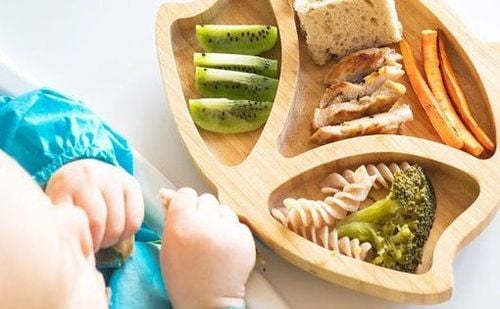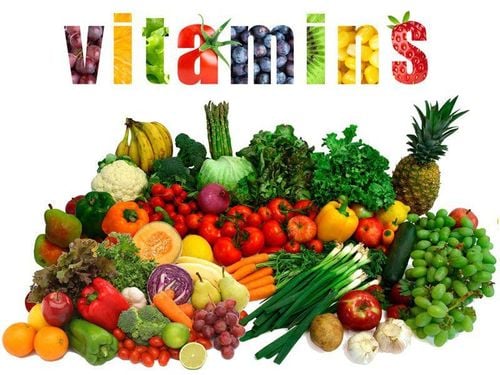This is an automatically translated article.
Children have an innate preference for sweet foods but can learn to like new foods through experience. Therefore, parents should start early to let their children eat vegetables so that they can adapt gradually. However, what vegetables should children eat when weaning and if they don't eat vegetables, is there any harm to their health?
1. Let your baby start eating solid foods from about 6 months
When the baby is 6 months old is the most suitable time for the baby to eat solid foods, to start weaning for the baby, the mother only needs to introduce the baby to a small amount of solid food once a day.
What vegetables do 6-month-old children eat? You can start introducing solids to single vegetables and fruits by mixing, mashing, or soft cooking, including: beets, broccoli, yams, sweet potatoes, carrots, and pears. , potato. You can also give your baby these vegetables along with his regular milk. You need to make sure that any cooked food is cooled down before giving it to your baby.
What vegetables can a 6-month-old child eat? It is important that you introduce each vegetable to your child, so that you can control your child's allergic reaction to a particular food. Because, with very small amounts of vegetables you can detect any reaction when your child eats it.
Vegetable food sources provide quite a lot of vitamins such as A, C, D, E... and essential minerals for the development of children. Besides, the high fiber content in vegetables helps eliminate excess substances from the body. Not only that, vegetables also provide the baby with a amount of water in the diet every day. So what are the harms in the case of children not eating vegetables?
The first harm to mention is the lack of daily vitamin content for children. At that time, it will directly affect the health of children and can cause oral diseases such as bleeding gums,... In addition, it also causes constipation for children due to low fiber supply. makes the digestive system of children less effective. At the same time, it reduces the stimulation of intestinal motility as well as promotes the growth of harmful bacteria...
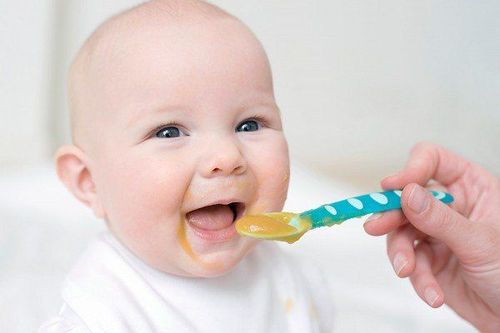
6 tháng là thời điểm lý tưởng nhất để trẻ làm quen với ăn dặm
2. Vegetables can be introduced to children at the time of weaning
What vegetables do 6-month-old children eat? For babies starting to eat solids you can introduce them to vegetables, including vegetables that are not too sweet, such as broccoli, cauliflower and spinach... this will help. your baby gets used to a variety of flavors (instead of just sweeter ones like carrots and sweet potatoes). Moreover, these vegetables can also help limit children's picky eating when they are growing up. Remember that babies don't need to add salt or sugar to their food (or cooking water). Babies should not eat salty foods because it is not good for the kidneys and sugar can cause tooth decay.
3. How to feed your baby solid food
The process of cooking baby food helps these foods become softer when used by children. In case your child is not used to hard foods, you can mash or mix vegetables to get the right texture. In your baby's weaning menu, you should offer a variety of vegetables and can include bitter ones: broccoli, turnip greens, peppers, peas, cauliflower, spinach, green beans , asparagus, kale, carrots, avocado, pumpkin, cabbage...
To help your baby quickly get used to foods with different textures and flavors, try switching foods mashed and tablet foods (from an ingredient or mixture) as soon as the baby is ready. This helps children learn to chew, move solid foods around their mouths, and swallow solid foods. Alternatively, you can give your child a spoon to try to feed themselves. It can take a long time for babies to get used to crumbs, but it's an important skill they need to learn. Just continue to offer these textured foods from about 6 to 7 months, and stay with them at all times to guide them to swallow safely. Finger foods also help children get used to different textures of foods, they like to pick up pieces of food and eat by themselves, which is also good for developing hand-eye coordination.
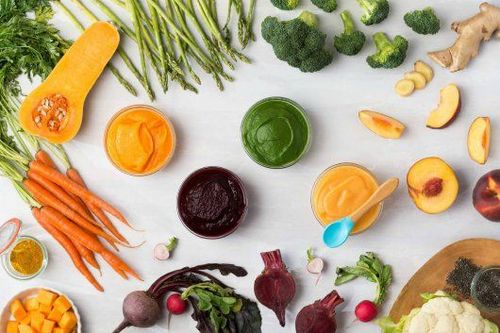
Các loại rau củ tốt cho chế độ ăn dặm của trẻ
3.1 Understanding finger foods As soon as your baby starts eating solid foods, encourage her to participate in mealtime and have fun touching, holding, and exploring food. Let your child feed himself with his fingers when he wants to. This helps develop fine motor skills and hand-eye coordination. So offering finger foods at every meal is a good way to help them learn to feed themselves.
Finger foods are foods that are cut into pieces large enough for a baby to hold in their hands and stick out slightly. Pieces the size of your fingers are just enough to feed your baby.
Besides, you should be careful to avoid hard foods, such as nuts or raw carrots and apples, to reduce the risk of choking in children.
Examples of baby foods:
Soft cooked vegetables, such as carrots, broccoli, cauliflower, coriander, butternut squash Fruit (soft, or cooked without added sugar), such as apples, pears, peaches, melons, bananas Pickable avocado slices Cooked starchy foods, such as potatoes, sweet potatoes, cassava, pasta, noodles, bread, rice Beans, such such as beans and lentils Boneless fish Hard-boiled eggs Boneless meat, such as chicken and lamb Pasteurized fatty hard cheeses (choose low-salt options)
4. What is baby-led weaning?
Child-led weaning means giving foods only with your hands and letting your baby start eating on his own (instead of spoon-feeding mashed or mashed foods). You can feed a variety of small foods with your fingers. Some parents prefer baby-led weaning to spoon-feeding, while others combine the two. There's no right or wrong way - the most important thing is that your child eats a variety of foods and gets all the nutrients he needs.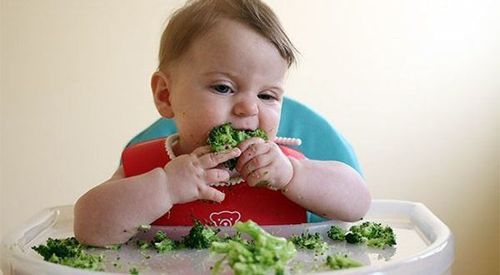
Ăn dặm cho bé chỉ huy là cho bé ăn thức ăn bằng tay và để trẻ tự ăn ngay từ đầu
5. Food safety and hygiene for children to eat solid foods
When introducing your baby to solid foods, you need to be very careful so that the baby is not in danger. Key food safety tips :
Practice hand washing before handling food and keep surfaces clean. Let hot foods cool and test them before giving them to your baby. Wash and peel the fruit. Avoid hard foods like nuts, raw carrots or apples. Separate hard seeds from fruit and bones from meat or fish. Cut small, round foods, like grapes and cherry tomatoes, into small pieces. Eggs are produced according to food safety regulations. Because, food source eggs are considered to be at risk of salmonella contamination and it is important to ensure that it is safe for children that they are fully cooked. Always stay with your child while he or she eats to prevent choking. In addition to paying attention to vegetables in their child's weaning diet, parents also need to remember that, when starting to eat solid foods, children often suffer from gastrointestinal diseases, the most typical of which is diarrhea and constipation. ..
In this case, the mother needs to be closely monitored, if the condition does not improve, she should immediately take her child to a nearby medical facility or a pediatric specialist - Vinmec International General Hospital to be examined by rich doctors. specialize.
For children to be healthy and develop well, it is necessary to have a nutritious diet in terms of quantity and quality balance. If children are not provided with adequate and balanced nutrients, it will lead to diseases of excess or lack of nutrients, which adversely affect the comprehensive development of children in terms of physical, mental and motor skills.
The period of baby eating solid foods is an extremely important period to help children develop comprehensively. Children who do not eat properly are at risk of micro-mineral deficiencies, causing anorexia, growth retardation, malabsorption, etc. If they notice the above signs, parents should supplement their children with supportive products. The supplement contains lysine, essential micro-minerals and vitamins such as zinc, chromium, selenium, and B vitamins to help fully meet the nutritional needs of children. At the same time, these essential vitamins also support digestion, enhance nutrient absorption, help improve anorexia, and help children eat well.
Parents can learn more:
Signs of zinc deficiency in children
Micronutrient deficiency and failure to gain weight in children
Please regularly visit Vinmec.com website and update useful information to take care of your child. Take care of the baby and the whole family.
Reference source: nhs.uk




